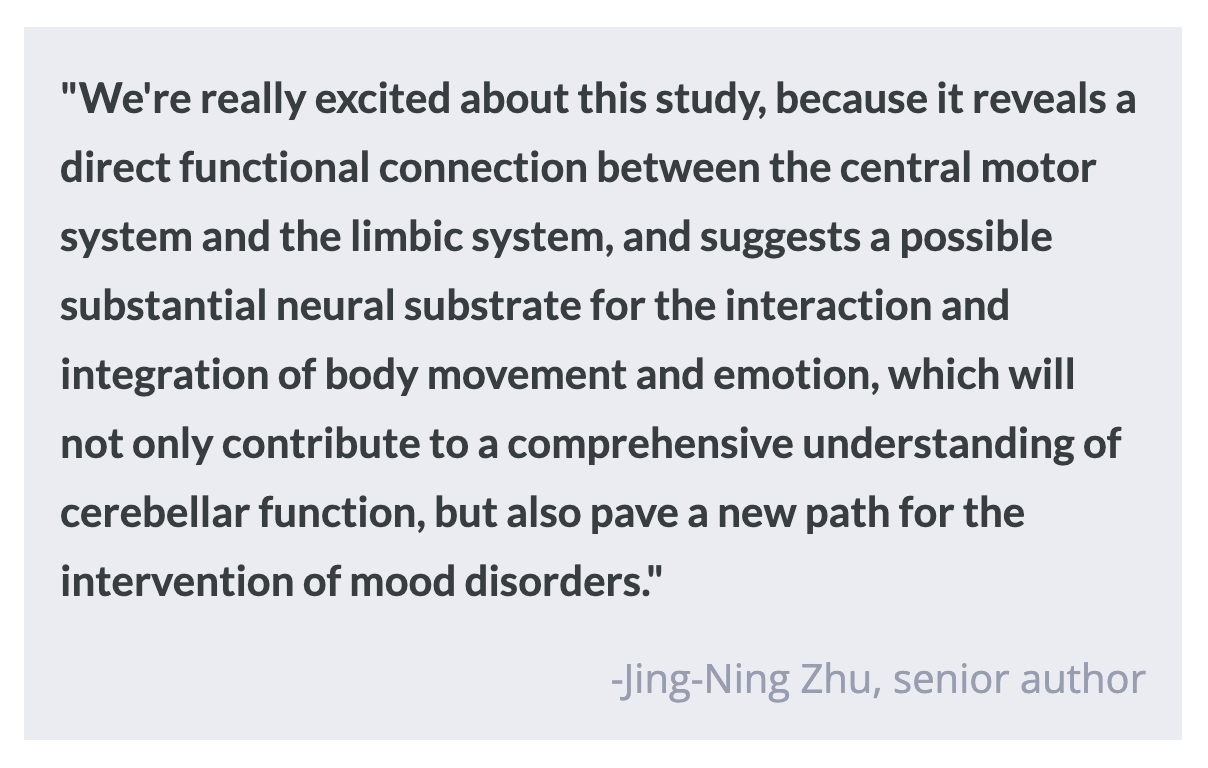Exercise and Movement-Triggered Anxiety Relief
Post by Baldomero B. Ramirez Cantu
The takeaway
This study elucidates the role of a previously unidentified neural circuit involving the cerebellum, amygdala, and hypothalamus in driving the anxiolytic effects of exercise.
What's the science?
Anxiety disorders constitute a spectrum of mental health conditions marked by enduring sensations of fear, apprehension, or discomfort. Exercise is hailed as a first-line and often successful intervention for managing anxiety symptoms. Despite the well-documented relationship between physical activity and anxiety reduction, the exact neural mechanisms underlying exercise's impact on anxiety remain incompletely understood.
The amygdala and hypothalamus are known to be key nodes in the brain's "anxiety circuitry”, contributing to the manifestation and regulation of anxiety-like behaviors. However, a much less explored brain region in this context is the cerebellum, a region primarily associated with motor function. Advancing our understanding of the interaction between anxiety and motor-associated brain regions could offer significant insights into how exercise modulates anxiety. This week, Zhang, Wu, Shen, Ji, et al. published a study in Neuron that investigates the functional connectivity among the cerebellum, amygdala, and hypothalamus in the context of exercise-induced anxiety relief, and provides one of the first pieces of direct evidence of cerebellar involvement in anxiety modulation.
How did they do it?
First, functional magnetic resonance imaging (fMRI) data were collected from humans to assess the functional connectivity between the cerebellum and amygdala as it relates to anxiety. This human study served as a starting point, establishing a relationship between the cerebellar-amygdala circuit and anxiety. Next, to study this circuitry with greater precision and understand the specific subregions and cell types involved in the exercise-induced amelioration of anxiety, the authors performed experiments in rats as model organisms.
Viral mediated tracing techniques, including anterograde and retrograde tracer injections, were used to map the direct projections from the dentate nucleus of the cerebellum to the central lateral amygdala. These experiments aimed to delineate the anatomical connectivity between cerebellar nuclei and amygdalar subregions, shedding light on the structural basis of cerebello-amygdalar circuitry involved in anxiety regulation. Viral tracing experiments were also performed in order to map the connectivity between the DN and orexin-expressing neurons in the perifornical area of the hypothalamus. The authors conducted fMRI scans on anesthetized rats to investigate the cerebellar-amygdala circuitry's functional connectivity between rats subjected to exercise and controls.
Finally, optogenetic and chemogenetic manipulations were employed in rats subjected to anxiety assays following rotarod running to elucidate the impact of motor activity on anxiety levels. These manipulations allowed researchers to selectively activate or inhibit cerebellar nuclei neurons projecting to the amygdala, providing insights into the causal relationship between cerebello-amygdalar circuitry and anxiety symptoms.
What did they find?
First, the researchers observed anxiety was negatively correlated with cerebello-amygdalar functional connectivity in humans. Next, they found reduced anxiety levels in rats subjected to rotarod running. For example, an increased preference for open arms in maze tests was observed (indicating an anxiety reduction), demonstrating that exercise had similar effects on the anxiety responses of rats and humans. Notably, functional connectivity analyses of rat fMRI scans revealed enhanced connectivity between the cerebellar nuclei and amygdala following motor activity.
They identified a direct cerebello-amygdalar projection, particularly from the dentate nucleus to the central lateral amygdala, suggesting a structural basis for regulation of anxiety-like emotions. Optogenetic and chemogenetic manipulations demonstrated that activation of cerebello-amygdalar projections significantly reduced anxiety-like behaviors in rats, while inhibition of this pathway attenuated the anxiolytic effects of exercise. Additionally, the researchers uncovered orexinergic hypothalamo-cerebellar projections as crucial components in anxiety regulation, particularly during challenging exercises. Activation of orexinergic neurons in the perifornical area of the hypothalamus alleviated stress-induced anxiety, highlighting the role of hypothalamo-cerebellar circuits in modulating anxiety behavior.
What's the impact?
This study significantly advances our understanding of the neural circuitry underlying anxiety regulation, particularly highlighting the previously unknown intricate interplay between the cerebellum, amygdala, and hypothalamus. This information is invaluable to our advancement of treatments and interventions for anxiety disorders.


